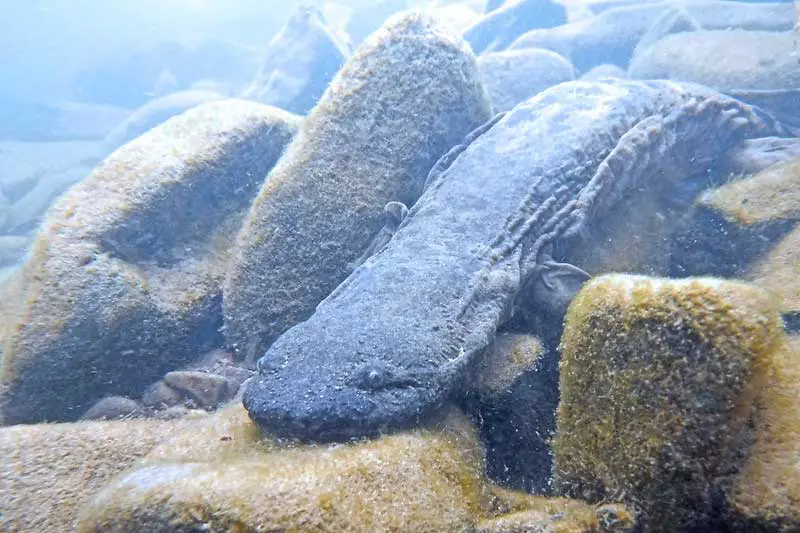When you first glance at them, salamanders look similar to lizards. However, salamanders are amphibians, not reptiles. They have smooth, moist skin with no scales or claws. Many of the salamanders in Ohio are delicate, small, and brightly colored.
Ohio has over 100 natural inland lakes that are 5 acres or larger and over 100 artificial inland lakes of 100 acres or larger. The north of Ohio also borders Lake Erie, with an area covering 9,940 square miles, making it the fourth-largest of the Great Lakes in North America. Most of the amphibians in Ohio live in various permanent water bodies like these. However, some salamander species are only land-dwelling as adults but prefer moist conditions that the state provides.
Let’s learn more about the 24 species of Salamanders you can find in the optimal habitats of Ohio.
24 Salamanders in Ohio
The 24 different species of salamanders in Ohio are the Eastern Hellbender, Northern Dusky Salamander, Mountain Dusky Salamander, Redback Salamander, Ravine Salamander, Northern Slimy Salamander, Four-Toed Salamander, Spring Salamander, Midland Mud Salamander, Northern Red Salamander, Green Salamander, Northern Two-Lined Salamander, Southern Two-Lined Salamander, Longtail Salamander, Cave Salamander, Spotted Salamander, Smallmouth Salamander, Blue-Spotted Salamander, Eastern Tiger Salamander, Jefferson Salamander, Marbled Salamander, Mudpuppy, eastern red-spotted newt, and the Streamside Salamander.
1. Eastern Hellbender

Scientific name: Cryptobranchus alleganiensis
The Eastern Hellbender averages 11.5 to 24 inches in length but can grow up to 27 inches, making it the state’s largest salamander and one of the big 3 giant salamanders in the world. Despite their size, they are quite harmless and an endangered species. You can find them in swift-flowing water habitats in south and east Ohio, where they hide under large rocks during the day.
2. Northern Dusky Salamander
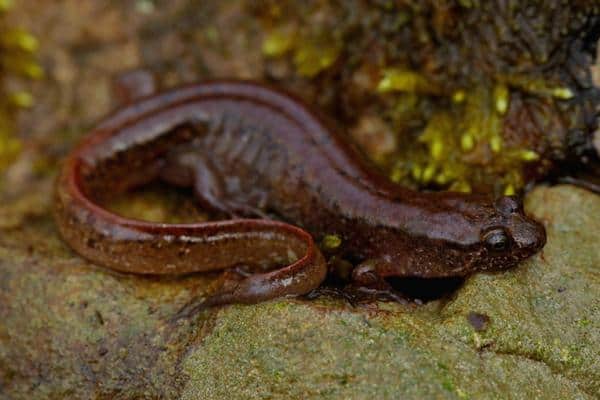
Scientific name: Desmognathus fuscus
The Northern Dusky salamander is a common species in Ohio, distinguishable by the light line extending from the back of their eyes to the back of their mouth. These salamanders grow an average of 2.5 to 4.5 inches in length. They enjoy flowing water habitats throughout Ohio, except the northwest regions.
3. Mountain Dusky Salamander
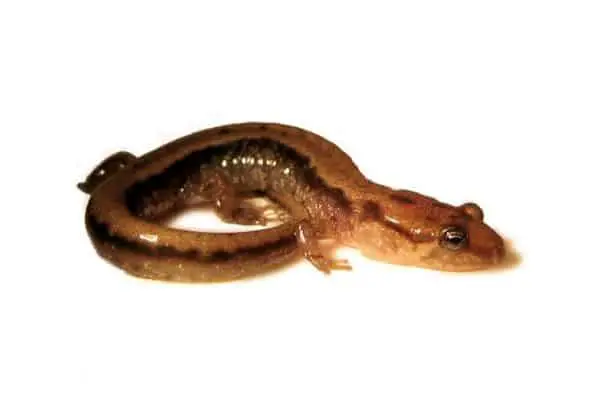
Scientific name: Desmognathus ochrophaeus
The Mountain Dusky Salamander can only be found in the extreme northeastern corner of Ohio. They look similar to the Northern Dusky Salamander, except they have a more rounded tail and stripes down their backs. These salamanders grow around 2.75 to 4 inches in length.
4. Red-backed Salamander
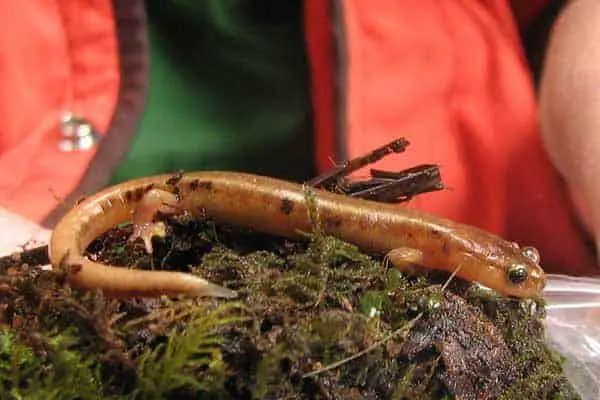
Scientific name: Plethodon cinereus
The Redback salamander is terrestrial and even lays its eggs in clusters under moist rocks or logs on land. They grow around 2.25 to 3.5 inches in length and are commonly found throughout Ohio. You can often see them during the early spring beneath logs and rocks, especially on floodplains.
5. Ravine Salamander

Scientific name: Plethodon electromorphus
As its name suggests, the Ravine salamander prefers the slopes of wooded ravines where it lives under logs and rocks. You can find them in most of southern and eastern Ohio. However, during midsummer, they burrow deep underground to seek moisture. These salamanders grow between 3 to 4.5 inches in length.
6. Northern Slimy Salamander
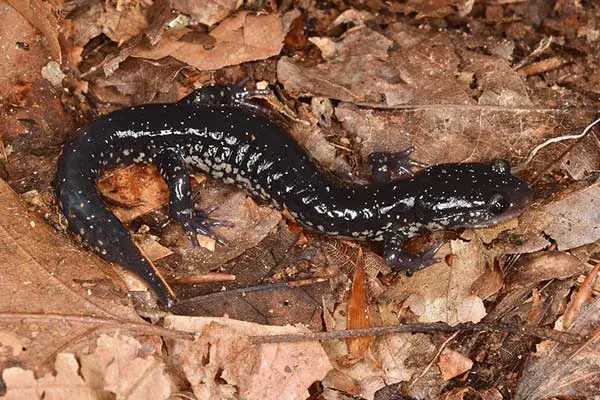
Scientific name: Plethodon glutinosus
The Northern Slimy salamander exists throughout Ohio, except for the northwestern areas. They grow between 4.75 and 6.75 inches in length and have very slimy skin secretions that can be very hard to wash off if they dry on your hands. These land-dwelling salamanders prefer moist areas under rotting stumps and logs.
7. Four-Toed Salamander
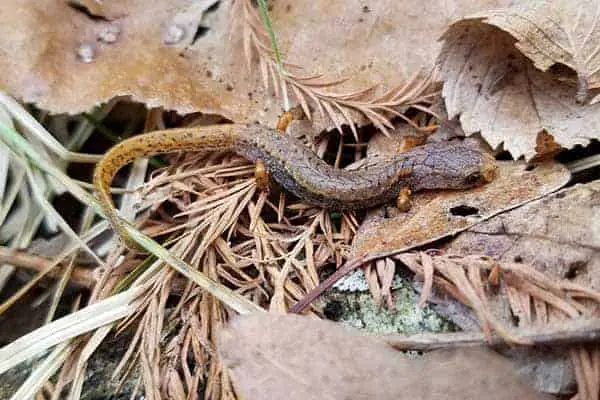
Scientific name: Hemidactylium scutatum
The tiny Four-toed salamander grows around 2 to 3 inches in length and is one of the two species with four toes instead of five. They also have a distinctive white belly with black speckles. You can find them scattered throughout Ohio, close to swamps and boggy woodland ponds.
8. Spring Salamander

Scientific name: Gyrinophulus porphyriticus
Spring salamanders are quite rare in Ohio and are mostly located in the southern and eastern areas of the state. They are between 4 to 7 inches in length and have two different races: the Kentucky Spring salamander and Northern Spring salamander. As their name suggests, they prefer flowing water habitats such as springs and clear woodland brooks.
9. Midland Mud Salamander
Scientific name: Pseudotriton montanus diastictus
The Midland Mud salamander prefers muddy habitats near slow woodland streams, seeps, and springs in the extreme southern part of Ohio. They have red bodies, brown irises, and a few black spots on their body. These salamanders grow between 3.5 to 6 inches in length.
10. Northern Red Salamander
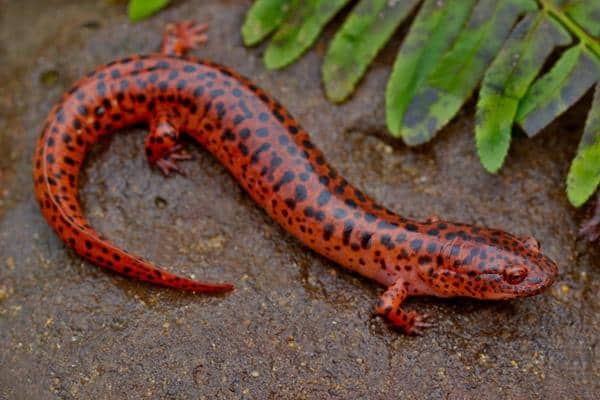
Scientific name: Pseudotrition ruber ruber
The adult Northern Red salamander is bright red with multiple scattered black spots. They are different from other red-colored salamanders because of their stout bodies and yellow-gold irises. These salamanders live in flowing water habitats throughout Ohio, except in the western and northwestern areas.
11. Green Salamander

Scientific name: Aneides aeneus
You can only find this rare endangered salamander species in the southern counties of Scioto, Adams, and Lawrence. The Green salamander grows between 3 to 5 inches in size and has a green and black pattern on its body. Their flattened head and body also make it easy for them to move in the moist cracks of sandstone and limestone cliffs they inhabit.
12. Northern Two-Lined Salamander
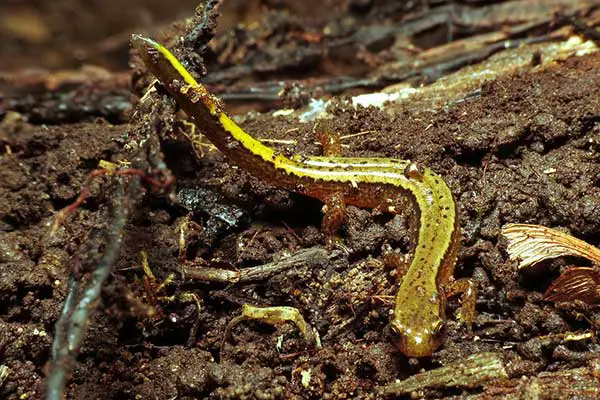
Scientific name: Eurycea bislineata
The Northern Two-lined salamander can be found north of Interstate 70 in springs, seeps, and small rocky streams. They grow between 2.5 and 3.75 inches in length and have two dark lines on either side of their yellow or golden-brown body.
13. Southern Two-Lined Salamander

Scientific name: Eurycea cirrigera
The Southern Two-lined salamander has similar physical attributes to the Northern Two-Lined salamander and lives in similar habitats, except they live mostly in the southern portion of Ohio. They are common to find but very difficult to catch or hold.
14. Longtail Salamander

Scientific name: Eurycea longicauda
As its name suggests, this salamander has a long tail over half the length of its body that grows up to 6.5 inches. They prefer shale banks and seep areas throughout the wooded and hilly regions of Ohio, except in the northwestern areas of the state.
15. Cave Salamander

Scientific name: Eurycea lucifuga
The Cave salamander is limited to Butler, Adams, and Hamilton counties in Ohio and is an endangered species protected by the Division of Wildlife. They are reddish-orange with dark spots and grow between 4 to 6 inches in length.
16. Spotted Salamander

Scientific name: Ambystoma maculatum
The Spotted salamander prefers standing water habitats throughout the entire state. They are common to find and grow between 6 to 7.75 inches in length. You can identify these salamanders by their two rows of greenish-yellow or yellow spots along their backs.
17. Small-mouthed Salamander
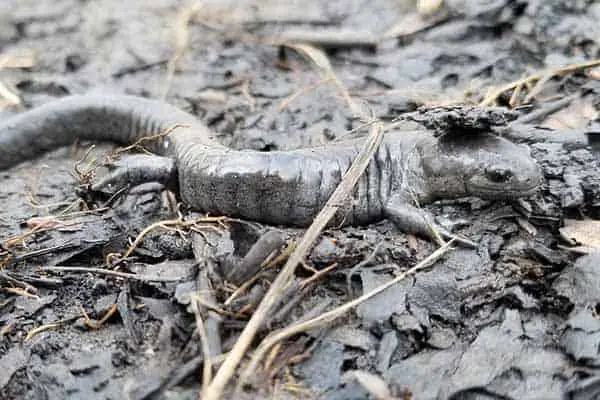
Scientific name: Ambystoma texanum
The Smallmouth salamander is suitably named since it has a small mouth and narrow, small head. However, it can grow up to 7.5 inches in length. They live throughout Ohio in standing water or terrestrial habitats, except for the extreme eastern areas of the state.
18. Blue-Spotted Salamander
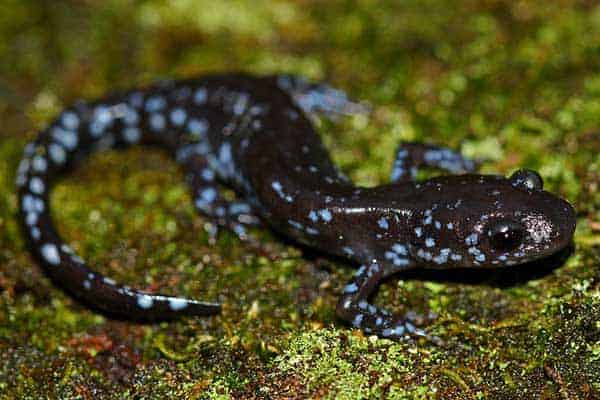
Scientific name: Ambystoma laterale
You can identify the Blue-Spotted salamander by the bluish-black body and blue specks, creating an appearance like old-fashioned enamelware. These salamanders grow between 4 and 6 inches in length and can only be found in the extreme northwestern counties of Ohio. Due to their limited habitat, they are considered endangered and protected.
19. Eastern Tiger Salamander
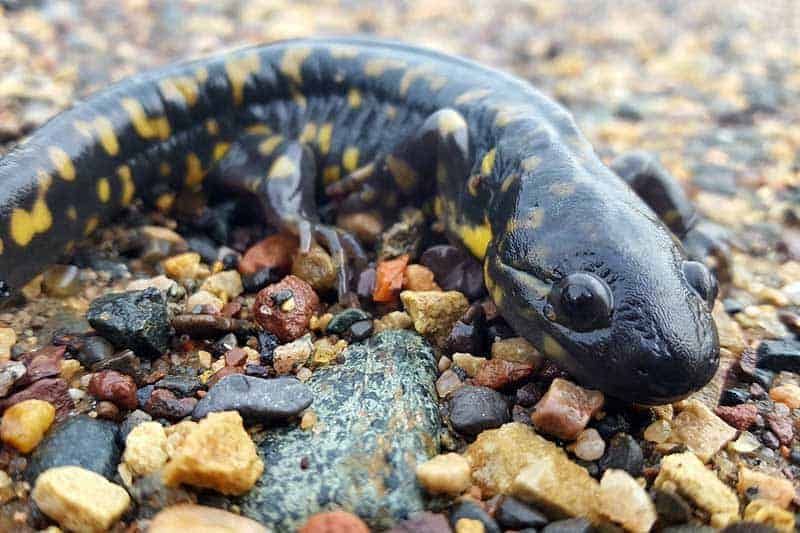
Scientific name: Ambystoma tigrinum tigrinum
The Eastern Tiger salamander grows between 7 to 8.25 inches in length and typically has light brown spots on a brownish-black body. They live throughout Ohio in terrestrial habitats where they burrow into the soil. However, you can see them when they migrate to ponds for breeding and show elaborate mating displays.
20. Jefferson Salamander
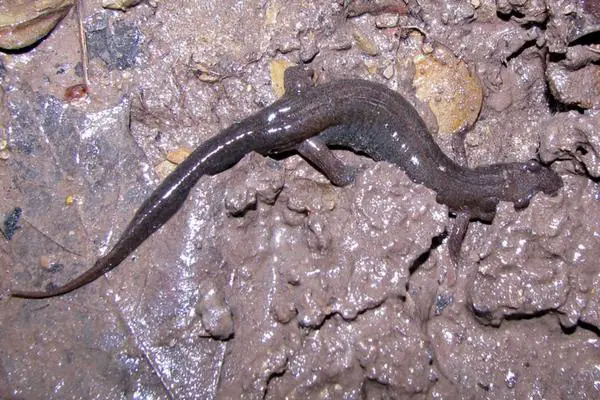
Scientific name: Ambystoma jeffersonianum
The Jefferson salamander is quite rare in Ohio, where you only see them when they enter ponds for breeding in the early spring. They grow between 4.5 to 7 inches, have long toes, and small silver-blue specks on their body. These salamanders prefer standing water habitats and moist woodlands throughout the state, except for the northwestern area.
21. Marbled Salamander
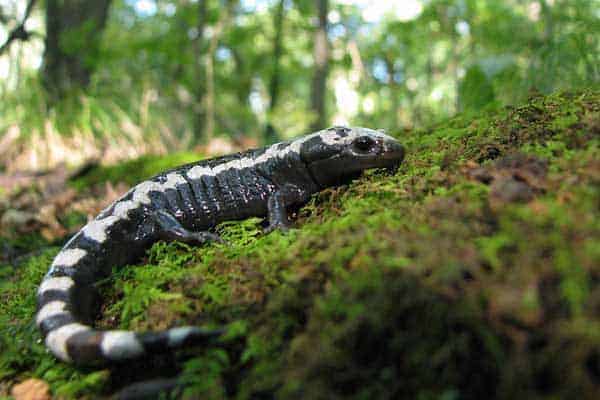
Scientific name: Ambystoma opacum
The Marbled salamander has distinctive marks on its body with bright white bands on black for males and grayish-white on black for females. They grow between 3.5 and 4.5 inches in length. Although you can find them in some northern lakeshore areas, they are more common in south Ohio.
22. Mudpuppy
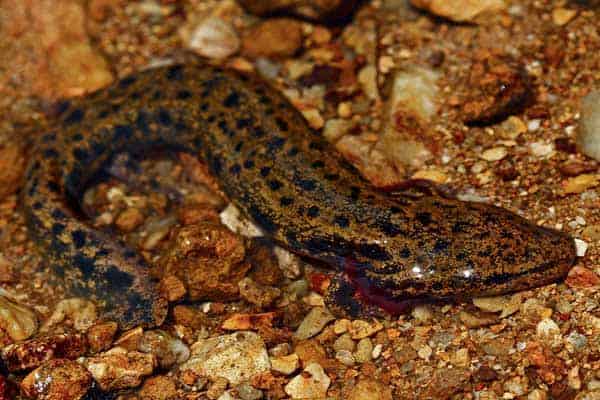
Scientific name: Necturus maculosus maculosus
Mudpuppies exist throughout Ohio in large rivers and streams, including Lake Erie. They are nocturnal and feed on aquatic insects and crayfish. These large salamanders grow between 8 to 13 inches in length and have flattened, broad heads. Unlike most other salamanders, the Mudpuppy has only four toes on its front feet instead of five.
23. Streamside Salamander

Scientific name: Ambystoma barbouri
These salamanders get their name because they prefer breeding in headwater streams instead of ponds like most salamanders. You can find them only in the southwestern counties of Ohio. The Streamside salamander grows around 4.5 to 5.5 inches in length and looks very similar to the Smallmouth salamander.
24. Eastern newt

Scientific name: Notophthalmus viridescens
The eastern newt is a very common salamander in the eastern half of the United States. The subspecies of the eastern newt found in Ohio is the red-spotted newt, they are found in most of the state.
Eastern newts live in deciduous and coniferous forests as well as bodies of water with muddy bottoms. They are between 2.5 and 5 inches in length as adults and feed on insects, fish, eggs and larvae, snails, slugs, and worms.
